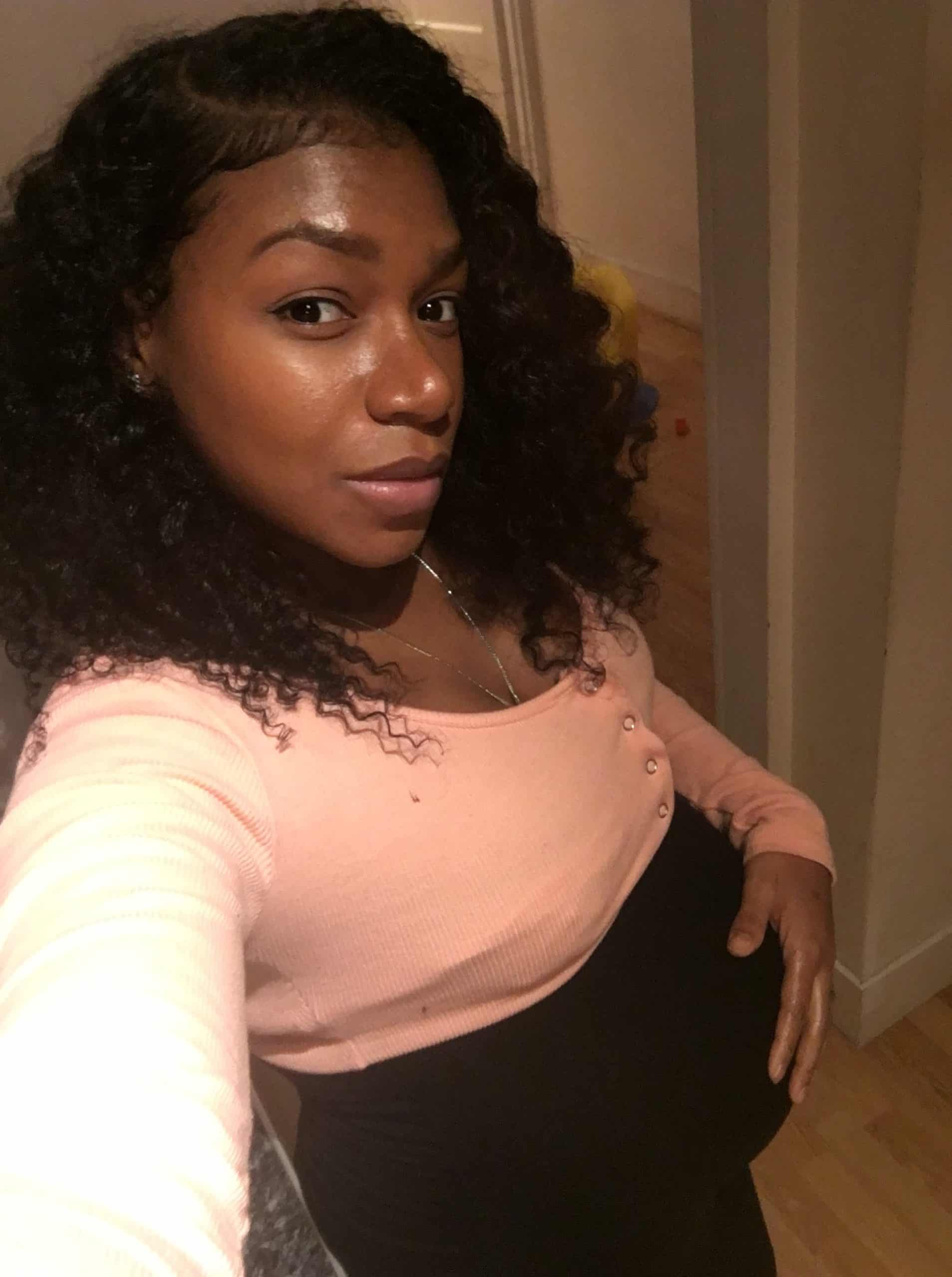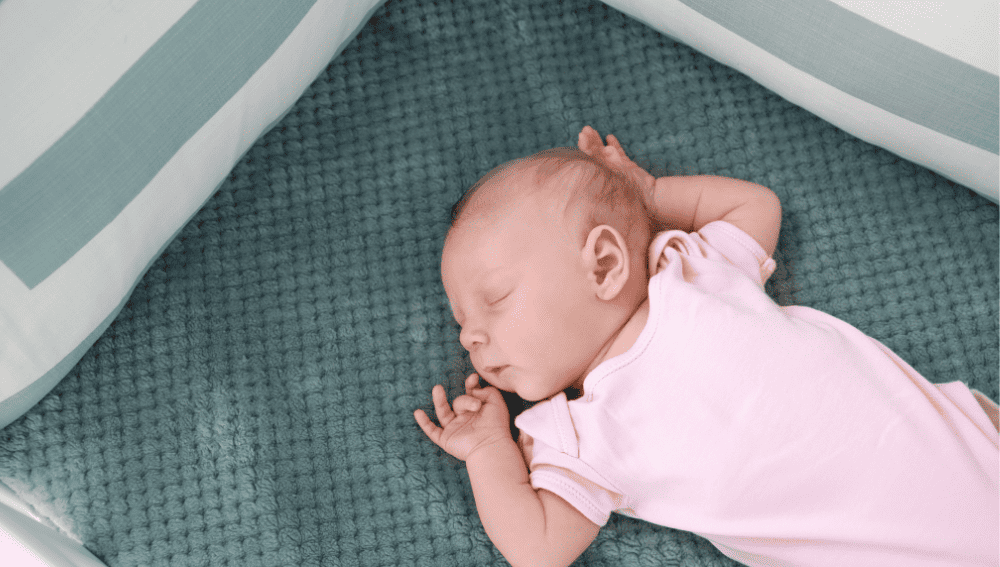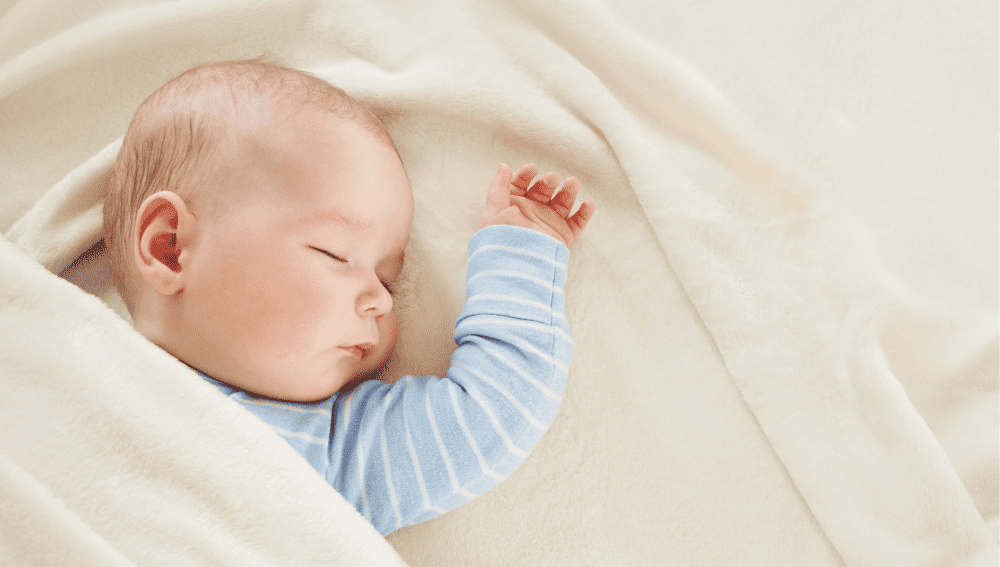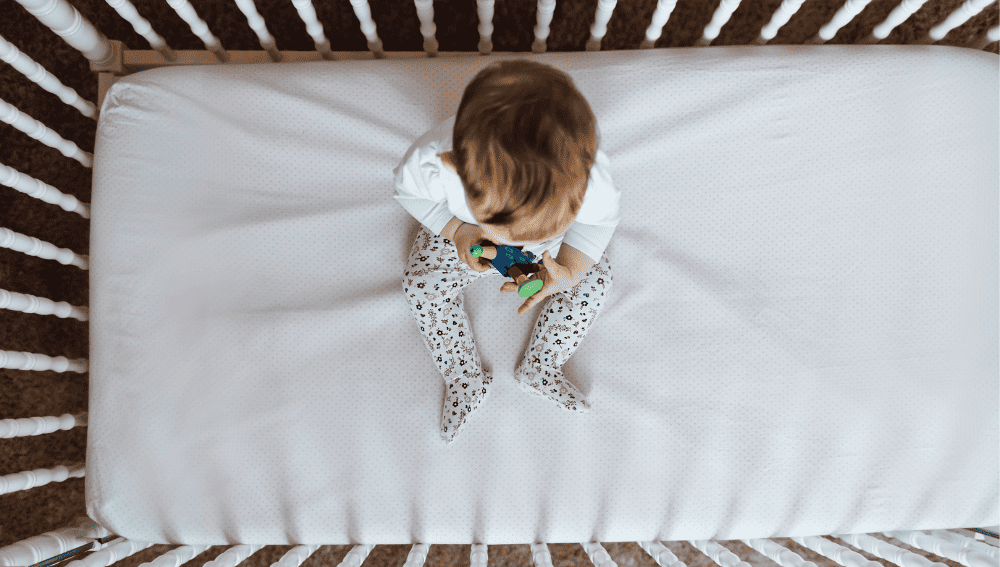Baby flailing arms and legs while sleeping is a common concern for many new parents. It can be alarming to see your little one thrashing around in their crib, but it’s important to understand that this is a normal part of their development. In fact, it’s a sign that their nervous system is maturing and developing properly.
Understanding Baby’s Sleep Patterns Babies have different sleep patterns than adults, and it’s important to understand these patterns in order to know what to expect.
Newborns sleep for about 16-17 hours a day, but they don’t experience the same deep sleep that adults do. Instead, they cycle through periods of light sleep and active sleep. During active sleep, babies may move around, make noises, and even open their eyes.
Key Takeaways
- Baby flailing arms and legs while sleeping is a normal part of their development.
- Understanding your baby’s sleep patterns can help ease concerns about their movements.
- Soothing techniques and choosing the right bedding can help promote better sleep for your baby.
Understanding Baby’s Sleep Patterns
Babies have a unique sleep pattern that differs from adults. They spend more time in REM sleep, which is a lighter sleep stage where they are more likely to move and have vivid dreams. This is why you may notice your baby flailing their arms and legs while sleeping.
Newborns typically sleep for 16-17 hours a day, but their sleep is often fragmented into short periods. As they grow, their sleep patterns become more consolidated, and they may start skipping naps during the day.
By the time they reach toddlerhood, most children will sleep for around 12 hours a day, including naps.
It is essential to establish a consistent sleep routine for your baby to promote healthy sleep habits. This includes creating a calming bedtime routine and ensuring they get enough sleep during the day.
Skipping naps can make your baby overtired, which can lead to difficulty falling asleep and staying asleep at night.
If you notice your baby flailing their arms and legs while sleeping, it is usually nothing to worry about. As long as they are sleeping comfortably and not disturbing their sleep, it is a normal part of their sleep pattern.
However, if you notice excessive movement or your baby seems uncomfortable, it may be worth speaking to a pediatrician to rule out any underlying health issues.
In summary, understanding your baby’s sleep patterns is essential for promoting healthy sleep habits. Creating a consistent sleep routine and ensuring they get enough sleep during the day can help prevent overtiredness and promote better sleep at night.
If you have any concerns about your baby’s sleep, it is always best to speak to a pediatrician for advice.
Baby Flailing Arms and Legs: An Overview
Babies are known to flail their arms and legs while sleeping, which can be concerning for parents. This movement disorder is common in infants and is usually harmless.
Flailing arms and legs are involuntary movements that occur during sleep. These movements can be random and uncoordinated, and they usually stop on their own. In some cases, babies may even wake themselves up with their movements.
There are various reasons why babies flail their arms and legs while sleeping. One possible explanation is that it is a reflex action that helps them develop their motor skills. Another possible reason is that it is a way for them to release excess energy before falling asleep.
In some cases, flailing arms and legs can be a sign of a more serious movement disorder. If a baby’s movements are excessive, rhythmic, or accompanied by other symptoms such as seizures, it is important to seek medical attention.
Overall, flailing arms and legs while sleeping is a common occurrence in babies and is usually nothing to worry about. However, if parents are concerned about their baby’s movements, they should consult with their pediatrician to rule out any underlying medical conditions.
Common Causes of Baby Flailing
Babies flail their arms and legs while sleeping for various reasons. Some of the common causes of baby flailing are discussed below:
Startle Reflex: One of the most common causes of baby flailing is the startle reflex. This reflex is also known as the Moro reflex and is an involuntary response to a sudden loud noise or movement. The baby’s arms and legs may jerk or flail in response to the startle.
Gas: Gas is another common cause of baby flailing. When babies have gas, they may become uncomfortable and restless, leading to flailing arms and legs.
Uncomfortable Sleeping Position: If the baby is uncomfortable in their sleeping position, they may flail their arms and legs to try and get comfortable. It is essential to ensure that the baby is in a comfortable sleeping position to prevent flailing.
Colic: Colic is a condition that causes babies to cry for long periods. It can also cause the baby to flail their arms and legs while sleeping.
Low Tolerance: Some babies have a low tolerance for certain things, such as changes in temperature or noise levels. These babies may flail their arms and legs in response to these stimuli.
Anger or Frustration: Babies can become angry or frustrated when they are unable to communicate their needs. This can lead to flailing arms and legs while sleeping.
In conclusion, several reasons can cause a baby to flail their arms and legs while sleeping. Parents should observe their babies closely to identify the cause of flailing and take appropriate measures to ensure their baby is comfortable and safe.
Developmental Aspects
Infants are known to flail their arms and legs while sleeping. This is a common behavior that can be observed in most babies. It is believed that this behavior is a result of the baby’s developing nervous system and is part of their normal development.
As babies grow and develop, they go through various developmental milestones. These milestones are important indicators of a baby’s growth and development.
Flailing arms and legs while sleeping is one such milestone. It is a sign that the baby’s nervous system is developing properly and that their balance is improving.
However, it is important to note that some babies may experience developmental delays that can affect their ability to flail their arms and legs while sleeping. These delays can be caused by a variety of factors, including genetics, environmental factors, and medical conditions.
Parents and caregivers should monitor their baby’s development closely and consult with a healthcare provider if they have any concerns. It is important to provide a safe and nurturing environment for the baby to promote healthy development.
In summary, flailing arms and legs while sleeping is a normal behavior in infants and is a sign of their developing nervous system and balance.
However, developmental delays can affect a baby’s ability to perform this behavior, and parents should monitor their baby’s development and seek medical advice if necessary.
Identifying Symptoms and Signs
When a baby flails their arms and legs while sleeping, it can be concerning for parents. However, it is important to understand that this is a normal and common occurrence in babies.
In some cases, it may even be a sign of healthy development.
Here are some symptoms and signs to look out for when your baby is flailing their arms and legs while sleeping:
- Crying: If your baby is flailing their arms and legs and crying, it could be a sign that they are uncomfortable or in pain. It is important to check for any obvious signs of discomfort, such as a dirty diaper or a fever.
- Falling: If your baby is flailing their arms and legs and falling out of bed or off of a surface, it is important to take precautions to ensure their safety. This may include placing pillows or blankets around the edges of the bed or using a crib with high sides.
- Clusters: If your baby is flailing their arms and legs in clusters, it could be a sign of a sleep disorder such as restless leg syndrome or periodic limb movement disorder. If you are concerned, speak to your pediatrician.
- Seizures: In rare cases, flailing arms and legs while sleeping could be a sign of a seizure disorder. If you suspect that your baby is having seizures, seek medical attention immediately.
It is important to remember that flailing arms and legs while sleeping is normal and usually nothing to worry about. However, if you are concerned about your baby’s movements or behavior while sleeping, it is always best to speak to your pediatrician.
Role of Reflexes in Baby’s Movements
Babies are known to flail their arms and legs while sleeping. This can be a concern for parents, especially when they are not sure if it is normal or not. One reason for this movement is due to the role of reflexes in a baby’s movements.
Reflexes are automatic responses to stimuli that are essential for a baby’s survival. These responses are controlled by the nervous system and do not require conscious thought. In babies, reflexes are more pronounced and can be triggered easily.
The Moro reflex is an example of a reflex that can cause a baby to flail their arms and legs while sleeping. This reflex is triggered by a sudden change in the baby’s position or a loud noise.
The baby will extend their arms and legs and then bring them back in towards their body. This reflex is also known as the startle reflex and is present in most newborns.
Another reflex that can cause movement in a baby is the rooting reflex. This reflex is triggered when the baby’s cheek is touched, and they will turn their head towards the stimulus. This reflex is essential for feeding and helps the baby find the breast or bottle.
The stepping reflex is another reflex that can cause movement in a baby. This reflex is triggered when the baby’s feet touch a surface, and they will lift one foot and then the other as if they are walking. This reflex disappears after a few weeks but is an important precursor to walking.
In conclusion, reflexes play a crucial role in a baby’s movements, especially while sleeping. The Moro reflex, rooting reflex, and stepping reflex are just a few examples of reflexes that can cause movement in a baby.
It is essential for parents to understand these reflexes to ensure their baby’s safety and development.
Medical Conditions and Baby Flailing
There are several medical conditions that can cause babies to flail their arms and legs while sleeping. These conditions can range from benign to serious, and it is important for parents to be aware of them.
Movement Disorders
Movement disorders such as restless leg syndrome or periodic limb movement disorder can cause babies to flail their arms and legs while sleeping. These disorders are characterized by involuntary movements during sleep and can cause disrupted sleep patterns.
Hip Dysplasia
Hip dysplasia is a condition where the hip joint does not form properly, resulting in an unstable joint. This can cause discomfort and pain for babies, which can lead to flailing movements during sleep.
Eczema
Eczema is a common skin condition that can cause itching and discomfort. Babies with eczema may flail their arms and legs during sleep in an attempt to relieve the itching.
Cluster
Cluster is a term used to describe a group of seizures that occur close together. These seizures can cause involuntary movements, including flailing of the arms and legs.
Injuries
Injuries such as fractures or sprains can cause discomfort and pain for babies, which can lead to flailing movements during sleep.
It is important for parents to consult with their pediatrician if they notice their baby flailing their arms and legs during sleep, as it could be a sign of an underlying medical condition.
Also read: How To Keep Baby’s Legs From Getting Stuck In A Crib?
Consulting a Pediatrician
If a family notices that their baby is flailing their arms and legs while sleeping, it is important to consult a pediatrician. A pediatrician can help determine if this behavior is normal or if it is a sign of a more serious issue.
Pediatricians are medical doctors who specialize in the care of infants, children, and adolescents. They have the knowledge and expertise to identify potential concerns and provide appropriate advice and treatment.
When consulting a pediatrician about a baby’s flailing arms and legs while sleeping, the pediatrician will likely ask about the baby’s sleep patterns, feeding habits, and overall health. They may also perform a physical exam to check for any underlying medical conditions.
It is important to be honest and open with the pediatrician about any concerns or observations. This will help the pediatrician make an accurate diagnosis and provide appropriate recommendations.
In some cases, the pediatrician may recommend further testing or referral to a specialist. It is important to follow their advice and guidance to ensure the baby receives the best possible care.
Overall, consulting a pediatrician is an important step in addressing any concerns about a baby’s flailing arms and legs while sleeping. The pediatrician can provide knowledgeable and confident guidance to help the family understand the best course of action for their baby’s health.
Soothing Techniques for Baby Flailing
When a baby is flailing their arms and legs while sleeping, it can be a sign of discomfort or restlessness. Fortunately, there are several techniques that parents can use to soothe their little ones and help them sleep more peacefully.
Swaddling
Swaddling is a classic technique that involves wrapping a baby snugly in a blanket or cloth. This can help them feel secure and prevent them from flailing their arms and legs. When swaddling, it’s important to make sure that the blanket is not too tight and that the baby’s hips have room to move.
Rocking
Rocking a baby gently can also help soothe them and calm their flailing movements. This can be done in a rocking chair, on a baby swing, or by gently bouncing them in your arms. The rhythmic motion can help lull them into a peaceful sleep.
Support
Providing support for a baby’s head and neck can also help them feel more comfortable and reduce their flailing movements. This can be done by using a supportive pillow or by placing a rolled-up blanket under their neck.
Drink
Offering a small amount of water or milk can also help soothe a restless baby. This can help them feel more comfortable and relaxed, and may reduce their flailing movements.
Toy
Providing a soft, cuddly toy or blanket can also help soothe a baby and make them feel more secure. This can be especially helpful for babies who are used to being held or cuddled while sleeping.
Overall, there are several techniques that parents can use to soothe a baby who is flailing their arms and legs while sleeping. By providing comfort and support, parents can help their little ones sleep more peacefully and wake up feeling refreshed.
Choosing the Right Mattress and Bedding
When it comes to babies, their comfort is of utmost importance. A good mattress and bedding can make a huge difference in their sleep quality and overall well-being.
Here are some factors to consider when choosing the right mattress and bedding for your baby.
Mattress
A good mattress should provide a firm and flat surface for your baby to sleep on. It should fit snugly in the crib without any gaps around the edges. Here are some types of mattresses to consider:
- Foam Mattress: These are lightweight and easy to move around. They are also affordable and can provide good support for your baby.
- Innerspring Mattress: These are more expensive than foam mattresses but provide better support and durability.
- Organic Mattress: These are made from natural materials and are free from harmful chemicals. They are a good option for parents who are concerned about their baby’s exposure to toxins.
Bedding
When it comes to bedding, safety and comfort are the top priorities. Here are some things to keep in mind:
- Fitted Sheets: Use fitted sheets that are specifically designed for your baby’s mattress. They should fit snugly and not come loose.
- Blankets: Avoid using loose blankets as they can pose a suffocation risk. Instead, use a wearable blanket or sleep sack to keep your baby warm.
- Pillows: Do not use pillows in the crib as they can also pose a suffocation risk. Wait until your baby is at least a year old before introducing a pillow.
Overall, choosing the right mattress and bedding for your baby can help them sleep better and stay safe. It’s important to do your research and choose products that are safe, comfortable, and fit your budget.
Medication and Treatment Options
In most cases, flailing arms and legs while sleeping is a normal part of a baby’s development and does not require medication or specific treatment. However, if the movements are frequent and severe, it may be a sign of an underlying medical condition that requires attention.
If the baby’s movements are interfering with their sleep or causing discomfort, the doctor may recommend medication to help manage the symptoms. The type of medication prescribed will depend on the underlying cause of the movements and the age of the baby.
For example, if the baby is experiencing seizures, the doctor may prescribe anticonvulsant medication to help control the seizures. If the movements are caused by restless leg syndrome, the doctor may prescribe medication to help manage the symptoms.
It is important to note that medication should only be used under the guidance of a doctor and should not be used as a first-line treatment for flailing arms and legs while sleeping.
In addition to medication, there are several other treatment options that can help manage the symptoms of flailing arms and legs while sleeping. These may include:
- Swaddling the baby to help them feel more secure and prevent excessive movement during sleep.
- Using a pacifier to help soothe the baby and reduce the frequency of movements.
- Providing a comfortable sleeping environment that is free from distractions and noise.
- Ensuring that the baby is getting enough sleep and is following a regular sleep schedule.
Overall, the treatment approach for flailing arms and legs while sleeping will depend on the underlying cause of the movements and the age of the baby. It is important to work closely with a doctor to develop a treatment plan that is safe and effective for the baby.
Related Posts:
Frequently Asked Questions
Why do babies flail their arms and legs while sleeping?
Babies flail their arms and legs while sleeping because their nervous system is still developing. This results in involuntary movements, which can be more pronounced during sleep.
Is it normal for babies to move their arms and legs while sleeping?
Yes, it is perfectly normal for babies to move their arms and legs while sleeping. In fact, it is a sign that their nervous system is developing properly.
What can cause a baby to flail their arms and legs while sleeping?
There are several factors that can cause a baby to flail their arms and legs while sleeping. These include overstimulation, discomfort, hunger, and developmental changes.
How can I help my baby sleep more peacefully?
To help your baby sleep more peacefully, you can try creating a calm and quiet sleeping environment, establishing a consistent bedtime routine, and ensuring that your baby is well-fed and comfortable.
What are some tips for soothing a baby who is flailing their arms and legs?
Some tips for soothing a baby who is flailing their arms and legs include swaddling, gentle rocking, and offering a pacifier. It is also important to ensure that your baby is not hungry or uncomfortable.
At what age do babies typically stop flailing their arms and legs while sleeping?
Babies typically stop flailing their arms and legs while sleeping between 3 and 6 months of age. As their nervous system continues to develop, their movements become more controlled and less involuntary.

Iesha is a loving mother of 2 beautiful children. She’s an active parent who enjoys indoor and outdoor adventures with her family. Her mission is to share practical and realistic parenting advice to help the parenting community becoming stronger.




